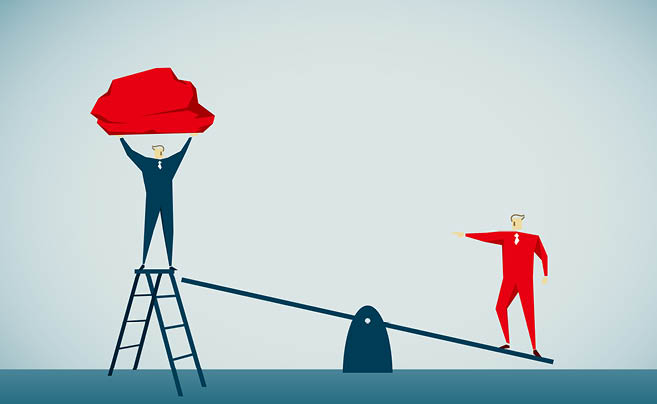High-trust environments make organisations efficient, engaging and highly innovative. In high-trust environments people feel confident sharing ideas because they know they will be sincerely listened to, and they know they can share their concerns without fear that others will become defensive. Furthermore, engagement increases as trust increases. In fact, an innovation survey conducted by PricewaterhouseCoopers shows that high-trust organisations outperform low-trust organisations by 286%.[i]
To inspire trust as a leader, the first and most important thing you must do is take responsibility for your own behaviour.
Case study:
One year when his company was off its numbers, Jonathan – the CEO of a beverage manufacturer and distributor – realised that the level of trust within his leadership team wasn’t very high. The team members were operating in silos and not communicating very freely with one another. Jonathan knew that fundamental changes were necessary, and that he, as their leader, needed to take responsibility and lead by example. As such, he organised a multi-day retreat with the leadership team to give them an opportunity to bond and to get everyone on the same page. The first thing Jonathan told his team was, “For our team to change, first I’m going to have to change.” He didn’t point fingers, and he didn’t place blame. Rather, he took personal responsibility for his team’s shortcomings, detailed where he felt he was failing, and made a public commitment to improve in specific areas. In doing so, Jonathan won the trust of his employees.
This case study isn’t fictional example that I’ve conjured up to highlight my point; Jonathan is one of the leaders featured in my book.
Trust is ultimately about opening yourself up to others, and making yourself vulnerable. You can’t be sure that your openness and candour will be reciprocated or appreciated, or even held in confidence, and you can’t be certain that others won’t take advantage of your openness. This is precisely why exemplary leaders such as Jonathan appreciate that they have to make themselves vulnerable and demonstrate their trust first. You can’t expect others to trust you if you are not willing to trust them.
Jonathan’s willingness to lead by example in creating a climate of trust laid the groundwork for his team, whose openness and willingness to collaborate cascaded down into the culture of the company. He created trust by breaking down barriers and making it safe for everyone else to share their deep concerns.
After making himself vulnerable, Jonathan also gently pushed his team – without confronting people individually – about their own levels of commitment. They all admitted that their commitment had been somewhat lacking. After hearing about his resolve however, they were prepared to sign up for a higher level of commitment. Jonathan recalled that, “That one conversation opened the door to a whole new culture of openness, authenticity and accountability.”
By having an open, authentic and honest dialogue about how they were operating, the team members were able to co-create a new strategy, vision and purpose. Ground rules were clarified and new ones were established.
Jonathan explained that, after a year of the new culture of vulnerability and accountability, “The quality of our conversations and authenticity has lifted through the roof. The principles and other things we’d signed up for are really working. Trust is emerging much more strongly, and everyone has become much more skilled at both giving and receiving feedback with good heart.”
Leaders like Jonathan know that they can’t make anything extraordinary happen without the engagement, commitment and hard work of others. They build trust by taking responsibility, and know leadership is not something that you do all by yourself; you do it in conjunction with other people. Trust and loyalty empower leaders to inspire the best in their teams; they also enable people to work collaboratively to achieve high-performance outcomes.
[i] Innovation Survey, PricewaterhouseCoopers, London, 1999, p. 3. See also PS Shockley‐Zalabak, S Morreale & M Hackman, Building the High‐Trust Organization: Strategies for Supporting Five Key Dimensions of Trust. San Francisco: Jossey-Bass, 2010.







